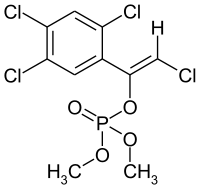Tetrachlorvinphos
 | |
| Names | |
|---|---|
| Systematic IUPAC name
(Z)-2-Chloro-1-(2,4,5-trichlorophenyl)vinyl dimethyl phosphate | |
| Other names | |
| Identifiers | |
| 22248-79-9 | |
| 3D model (Jmol) | Interactive image |
| ChemSpider | 4447527 |
| ECHA InfoCard | 100.040.772 |
| UNII | DM33MW89QU |
| |
| |
| Properties | |
| C10H9Cl4O4P | |
| Molar mass | 365.95 g·mol−1 |
| Melting point | 97 to 98 °C (207 to 208 °F; 370 to 371 K)[3] |
| Pharmacology | |
| QP53AF14 (WHO) QP53BB04 (WHO) | |
| Except where otherwise noted, data are given for materials in their standard state (at 25 °C [77 °F], 100 kPa). | |
| Infobox references | |
Tetrachlorvinphos is an organophosphate insecticide used to kill fleas and ticks.[2]
History
Tetrachlorvinphos was initially registered for use in the United States in 1966 by the U.S. Department of Agriculture. Tetrachlorvinphos was originally registered for use on various food crops, livestock, pet animals, and in or around buildings. The crop uses were voluntarily canceled from product registrations in 1987. [4] In 2014, the Natural Resources Defense Council (NRDC) filed a lawsuit against the United States Environmental Protection Agency (EPA) seeking EPA to respond to NRDC’s 2009 petition to ban tetrachlorvinphos in common pet flea treatment products. [5][6]
Human health hazards
Symptoms of exposure to this material include increased perspiration, nausea, lachrymation, salivation, blurred vision, diarrhea, pulmonary edema, respiratory embarrassment and convulsions. The chemical material may be absorbed through the skin and is a lachrymator. It is a cholinesterase inhibitor and is a positive animal carcinogen. [7]
Chemical properties
The substance is insoluble in water. Flash point data are not available for this chemical; however, it is probably combustible. Tetrachlorvinphos is slowly hydrolyzed in neutral and aqueous acidic media. Is rapidly hydrolyzed in alkaline media. [8]
Alternative Chemical Names
This is a listing of alternate names for this chemical, including trade names and synonyms. [9]
- BENZYL ALCOHOL, 2,4,5-TRICHLORO-ALPHA-(CHLOROMETHYLENE)-, DIMETHYL PHOSPHATE
- 2-CHLORO-1-(2,4,5-TRICHLOROPHENYL)VINYL DIMETHYL PHOSPHATE
- 2-CHLORO-1-(2,4,5-TRICHLOROPHENYL)VINYL PHOSPHORIC ACID DIMETHYL ESTER
- DIMETHYL 2,4,5-TRICHLORO-ALPHA-(CHLOROMETHYLENE)BENZYL PHOSPHATE
- GARDONA
- IPO 8
- NCI C00168
- PHOSPHORIC ACID, 2-CHLORO-1-(2,3,5-TRICHLOROPHENYL) ETHENYL DIMETHYL ESTER
- PHOSPHORIC ACID, 2-CHLORO-1-(2,4,5-TRICHLOROPHENYL)VINYL DIMETHYL ESTER
- RABON
- RABOND
- TETRACHLORVINPHOS
- 2,4,5-TRICHLORO-ALPHA-(CHLOROMETHYLENE)BENZYL ALCOHOL DIMETHYL PHOSPHATE
- 2,4,5-TRICHLORO-ALPHA-(CHLOROMETHYLENE)BENZYL PHOSPHATE
References
- 1 2 Tetrachlorvinphos, alanwood.net
- 1 2 "Tetrachlorvinphos (TCVP)". Natural Resources Defense Council.
- ↑ "Tetrachlorvinphos". Sigma-Aldrich.
- ↑ http://www.epa.gov/oppsrrd1/REDs/factsheets/0321fact.pdf
- ↑ http://ecowatch.com/2014/02/06/epa-sued-over-pesticides-flea-collars/
- ↑ http://www.nrdc.org/media/2014/140206.asp
- ↑ http://cameochemicals.noaa.gov/chemical/16121
- ↑ http://cameochemicals.noaa.gov/chemical/16121
- ↑ http://cameochemicals.noaa.gov/chemical/16121
This article contains public domain text from the EPA and the NOAA .